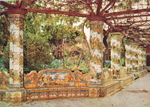 New Castle
New Castle This castle represents one of the symbols of Naples. It was called "new castle" since its construction in order to distinguish it from the other more ancient fortresses of Ovo and Capuano. This castle is also called "Maschio Angioino" (Angevin Donjon) because it was built by the king Charles I d'Anjou (1279-82) under the direction of the French architect Pietro da Chaules on the spot where some Franciscans had founded their house of Santa Maria ad palatium.
The Arch of Triumph of this castle is considered the most beautiful example of the Renaissance in Naples.
 Royal Palace of Naples
Royal Palace of Naples The Royal Palace of Naples was built by Domenico Fontana in 1602. Destroyed by a fire in 1837, it was restored by Gaetano Genovese (1841). On the sea-side of the building, on the first floor, there is a beautiful Roof Garden from where You can enjoy a spectacular view of the gulf of Naples.
In addition, a big part of the first floor has been changed into a museum whilst in the east-side of the building the National Library is kept.
 Town Hall Square
Town Hall Square Town Hall Square is the largest square in Naples, and ideally situated. On one side there is the maritime station, with ships which seem about to enter the city itself, anchored as they are right at the city's edge. On the other side is the palace of S. Giacomo, the seat of Bourbon Ministers, the seat of Local Administration since 1860. Behind it is the hill on which stands the Carthusian Monastery of S. Martino. To another side is Via Medina, which leads into the parish of the Church of S. Chiara, and opposite this the lawns above which towers the Castello Angioino.
It is a breathtaking for the irregularity of its form, for the variety of the historical buildings surrounding it, and for the dazzling sight of the sea and the olive hill on which S. Martino is built.
In the center of the square there is an equestrian statue of the king Victor Emanuel II of Savoy.
 The cloister of Santa Chiara
The cloister of Santa Chiara
The church of Santa Chiara is for sure the dearest to the hearts of Neapolitans, especially today when so little of it remains after the fire of the last war. Benedetto Croce, after the war, said that if they had opened his heart they would have found two great wounds: the destruction of the State Archive of Naples, burnt by the Germans, and the burning of S. Chiara, when on the 4th August 1943, the magnificent baroque gold decorations were melted by the heat, the stone of the Angevin tombs corroded, the frescoes burnt, the marbles of Tino da Camaino destroyed, canvases and carvings gutted, and the tall cedars of Lebanon, which formed the roof of the 14 century Church thrown to the ground.
It was the most Neapolitan of them all, both because of its dynastic links (not only the Angevins, but the pious Maria Christina of Bourbon, wife of Ferdinando II, was buried there), and because of its primitive Gothic skeleton on which the baroque had created a triumph of decoration, with kilos of gold volutes and flowers carved in wood.
It has not been possible to do more than restore the primitive skeleton, and it has become a fine Gothic Church – fine, but like so many throughout Europe; so it is not longer ‘the Church’ of the Neapolitans.
Fortunately, the great majolica cloisters remain untouched, an oasis of 18th century rustic, with vine branches held back by the pillars, and seats where delicate tiles with festoons, scenes, and allegories run. A work unique of its kind, the Cloisters of S. Chiara is among those things that one must see in Naples, if one wants to understand the spirit of the city better, and its festive religiousness, its ingenuous feeling of mysticism, which make it a place to gather and to pray – as a convent cloister – a hymn to the gentleness and grace of art. In one room of the cloister is the great 18th century crib built by Father Gaudenzio dell’Aja o.f.m., which one may visit throughout the year.